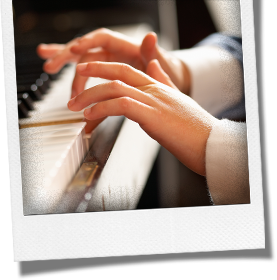The Royal Conservatory of Music (RCM) is one of the largest and most respected music education institutions in the world, providing the definitive standard of excellence in curriculum design, assessment, performance training, teacher certification and arts-based social programs.
All students registered at Silver Creek Music Studios are enrolled in the Royal Conservatory of Music (RCM) Certificate program. The curriculum encompasses study of various genres including Baroque, Classical, 20th & 21st century, Romantic era repertoire, Inventions, and popular music. Although not part of the RCM curriculum, students are offered opportunities in creative arranging and improvisational study.
In addition, technique, sight reading and ear tests form an integral part of the students regular lesson and practise requirements at every level.
The Certificate Program consists of practical and theory examinations. Certicates are awarded for successful completion of each practical and theory examination. Beginning at Level 5, a Comprehensive Certificate is awarded upon completing both the practical and theory examinations.
Preparatory A level
Students at the Preparatory A level acquire familiarity with the basic keyboard geography, formation of pentascale patterns, and the fundamentals of note reading and rhythm. Repertoire is chosen from a variety of method books and contemporary collections. The Prep A examination facilitates the student's transition from method books into the Certificate Program.
Preparatory B level
Students at the Preparatory B level continue their exploration of the keyboard. A selection of pentascales, full octave scales, contrary motion scales, and triads with inversions supports the development of technical facility. Repertoire is chosen from a variety of method books and contemporary collections. Traditional favorites from the early pedagogical repertoire are presented as material for study along with more contemporary styles.
ELEMENTARY LEVELS (1 - 4)
Level 1
Students in Level 1 are introduced to elements of Baroque and Classical style through miniature dance and song forms. Character pieces provide opportunities for developing imagination and creativity, while inventions encourage hand independence. Two-octave scales support the development of agility and fluency.
Level 2
Students in Level 2 expand their musical horizons and develop technical skills by exploring a variety of musical styles and genres. Character pieces allow for exploration of pedaling, expression, and balance of tone. Scales and triads introduce new major and relative minor keys.
Level 3
At Level 3, students continue to explore Baroque dance forms. Classical sonatinas provide opportunities to refine control of touch and tone and increase awareness of formal structure. Hands-together scales support the repertoire requirements by encouraging coordination and rhythmic precision.
Level 4
At Level 4, students encounter a broader range of genres and textures. Classical sonatinas present new accompaniment styles and pianistic figurations. Selections from the Romantic and contemporary periods offer new musical and technical challenges. Scales and triads are played in a wider range of keys, and arpeggios are introduced.
INTERMEDIATE LEVELS (Levels 5 - 8)
Level 5
At Level 5, students encounter longer and more varied forms, fuller harmonic textures, and an increasingly sophisticated interplay of melody and accompaniment. Technical requirements expand to include dominant 7th chords.
Co-requisite: Basic Rudiments
Level 6
Students continue to explore intermediate-level repertoire in a variety of styles. Challenges include clear voice leading in polyphonic textures, rhythmic control in longer sonatina movements, and imaginative expression in Romantic repertoire. The introduction of several new keys and faster tempos to technical requirements encourages greater technical facility.
Co-requisite: Intermediate Rudiments
Level 7
Level 7 serves as a vital link in preparation for advanced study. Baroque repertoire selections include dance forms and two-part inventions, and Classical sonatinas expand to more complex phrase structures and accompaniment patterns. The inclusion of four-note chords in technical requirements supports the development of a wider hand span reflecting the increasing demands of the repertoire.
Co-requisite: Advanced Rudiments
*Completion of the practical and theory component may qualify a student for a credit towards their secondary school diploma. For more information, please visit: Ontario Schools: Kindergarten to Grade 12 (page 72 - 73 and Appendix 4)
Level 8
Level 8 is the culmination of the Intermediate stage of the Certificate program. Students perform repertoire from four historical style periods, each with its own characteristic features. From this level onward, students encounter masterworks of the pianist's core repertoire. Technical requirements now include four-octave scales and arpeggios.
Co-requisite: Advanced Rudiments
*Completion of the practical and theory component may qualify a student for a credit towards their secondary school diploma. For more information, please visit: Ontario Schools: Kindergarten to Grade 12 (page 72 - 73 and Appendix 4)
ADVANCED LEVELS (Level 9 - 10)
Level 9
At Level 9, Baroque contrapuntal works, larger-scale Classical sonata movements, and etudes and character pieces from the Romantic and contemporary periods all serve as effective vehicles for pianistic development. Technical requirements in a wide range of keys reflect the increasing demands of the repertoire.
Co-requisite: Basic Harmony or Basic Keyboard Harmony and History 1: An Overview
Level 10
Level 10 provides a stimulating combination of challenges through more demanding and varied repertoire selections and enhanced technical requirements. Three- and four-part contrapuntal textures, contrasting movements of Classical sonatas and more complex Romantic and contemporary repertoire and etude selections provide the inspiration for students' developing artistry. The examination's comprehensive testing prepares students for the challenges of the diploma-level concert presentation.
*The Royal Conservatory of Music is the "standard excellence in music education in North America" since 1886. Over 5 million Canadians are alumni of the Royal Conservatory of Music. For more information visit The Royal Conservatory of Music

